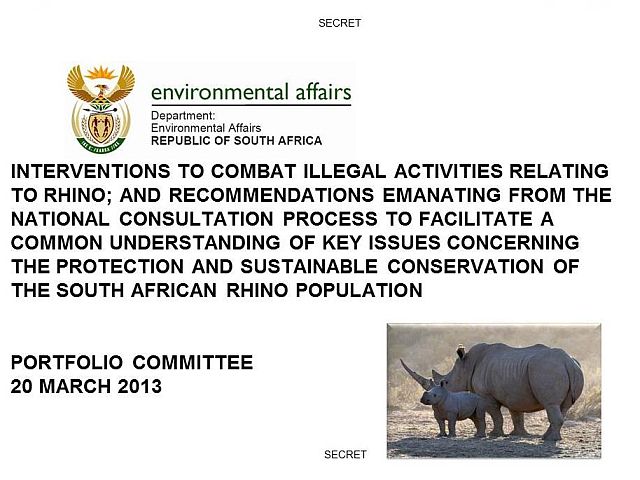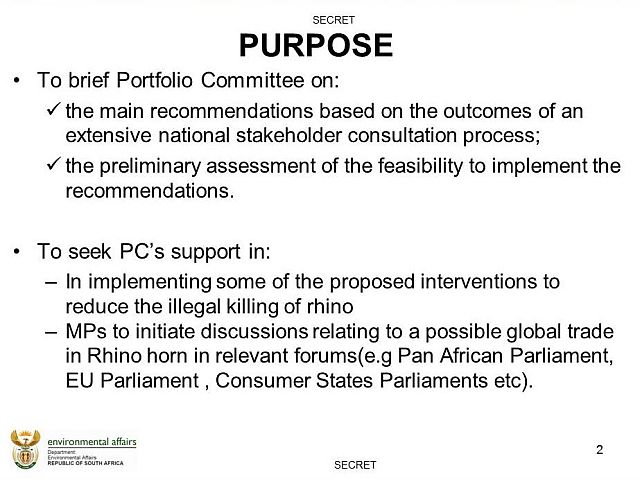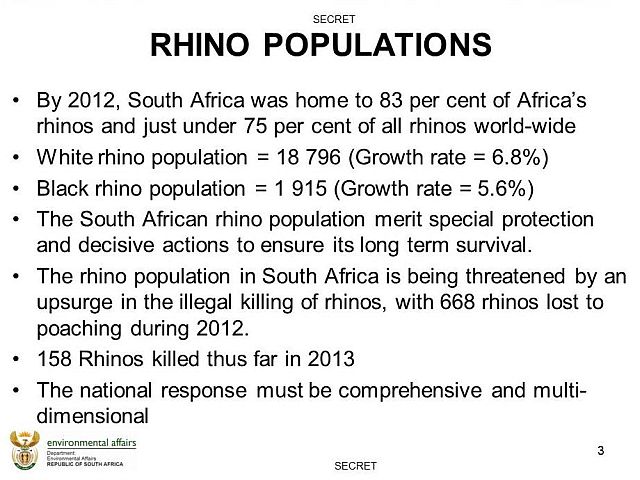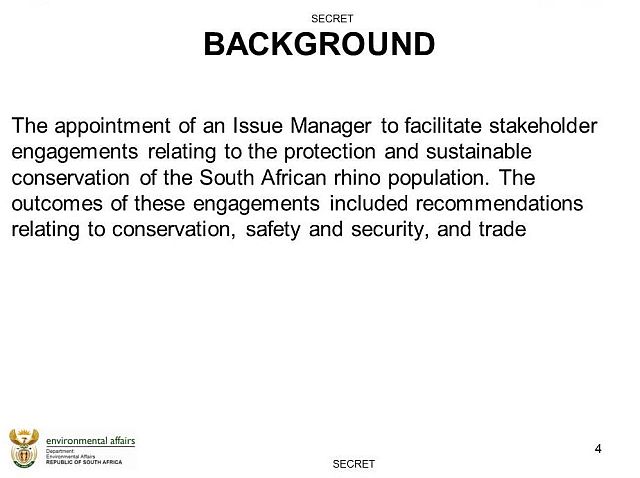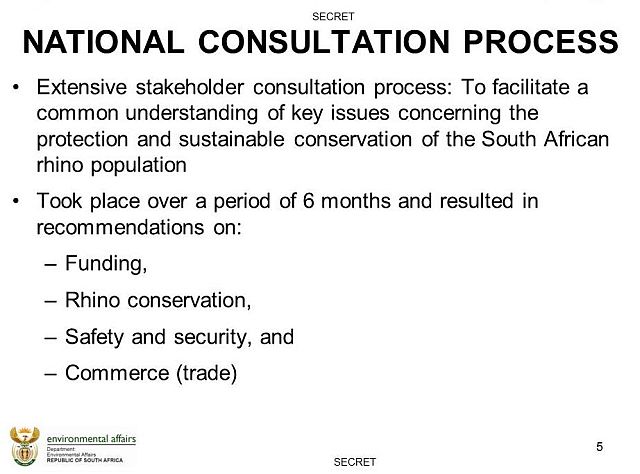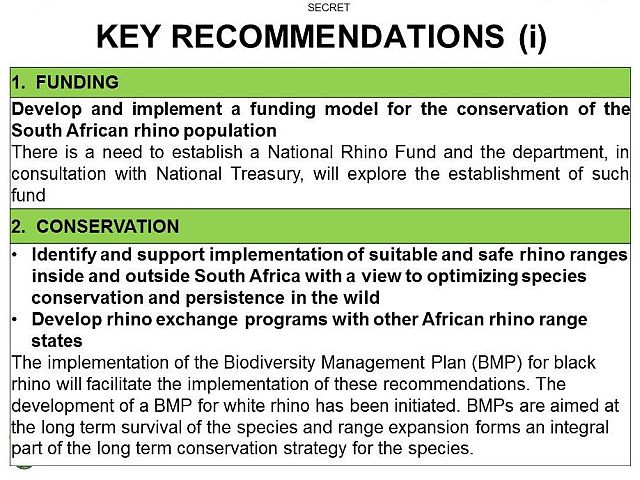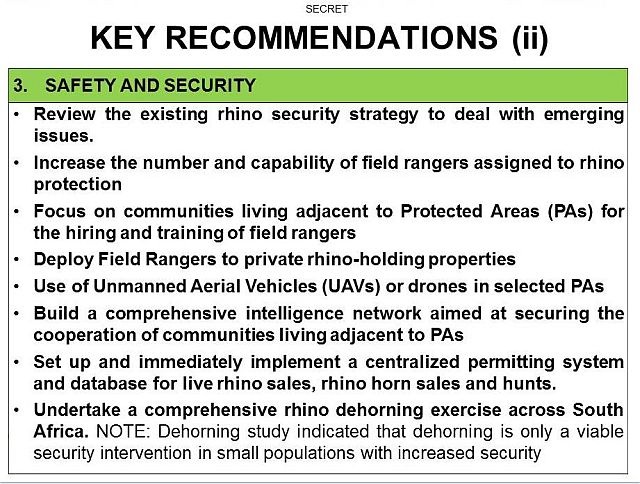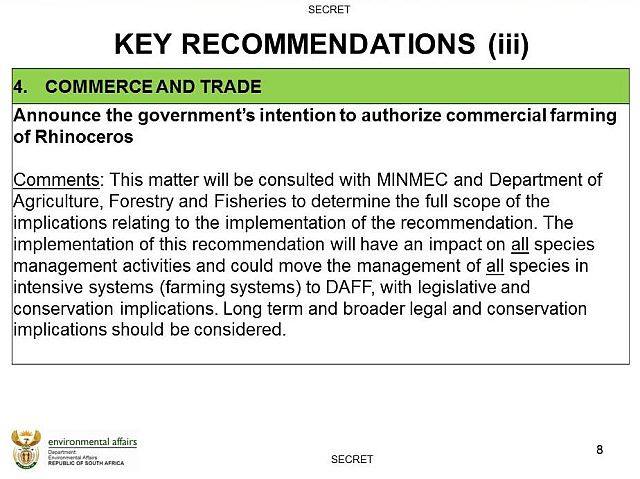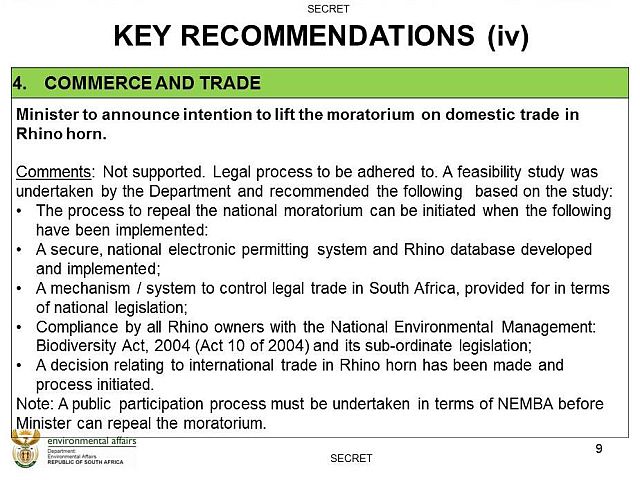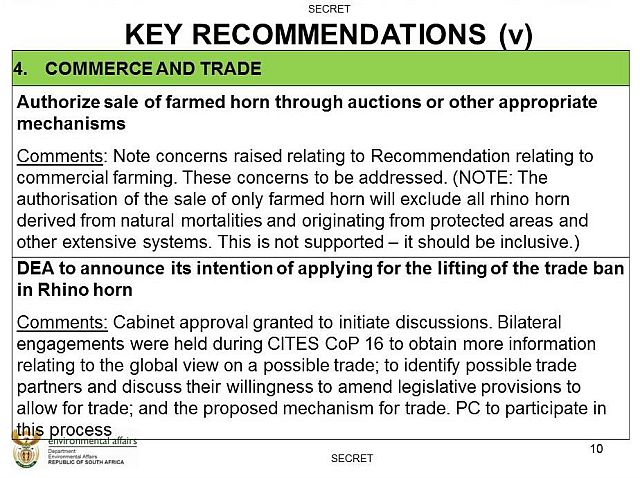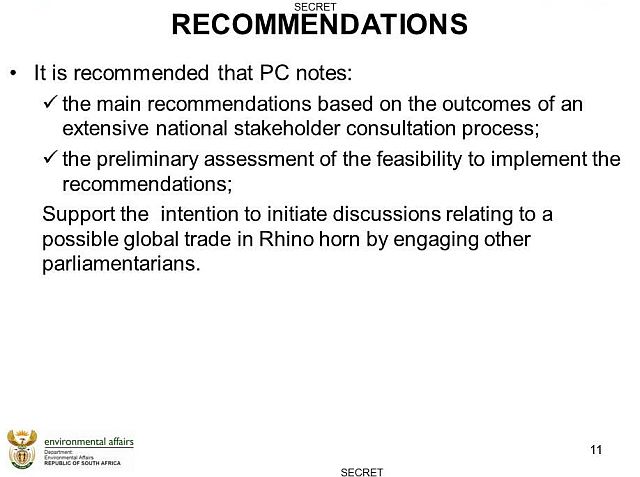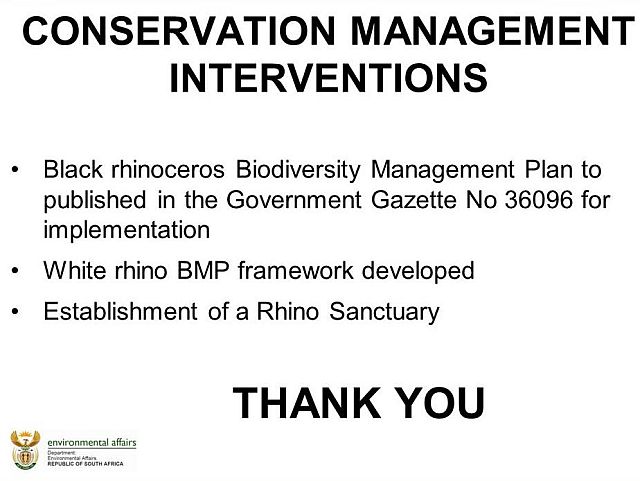Update on Rhino Poaching, Convention on International Trade in Endangered Species of Wild Flora and Fauna (CITES) Report & Hunting Indaba: briefings by Department of Environmental Affairs
Water Affairs and Environmental Affairs
Date of Meeting: 20 Mar 2013
Chairperson: Mr J de Lange (ANC)
Documents handed out:
SA Weather Service Strategic / Annual Performance Plan 2013/14 - 2017/18
DEA 2012 Hunting Indaba Action Plan
Hunting Indaba Final Report
RIM Final Recommendations Report November 2012
RIM Report March 2013
Briefing on CITES COP16 Outcomes
Briefing on Hunting Indaba
Progress Report on Rhino Poaching
Biodiversity and Conservation Branch and Public Entity Strategy / Annual Performance Plan 2013/14 – 2017/18
Committee Programme 2nd Term
Audio recording of the meeting:
PC Water: Department of Environmental Affairs on the Strategic Plans 2013-2016 and Budget Votes 2013/14
Summary:
The Department of Environmental Affairs (DEA) briefed the Committee on the issue of rhino poaching. Members were briefed on the latest statistics. There had already been 158 cases during 2013, but generally the number of cases was reducing. Conviction rates had been increasing and the court process had been reduced considerably. South Africa was co-operating with a number of neighbouring states, but Members felt that the progress with formalising these agreements was too slow. The country had taken criticism at international forums for a perceived lack of willingness to tackle the issue.
The number of applications for hunting permits had declined, although the hunting sector still made a big contribution to the economy. Information was needed on the stockpile of rhino horn being held in both government and private hands. Progress was being made on creating a rhino sanctuary. It was accepted that specialist training was needed for investigators, prosecutors and the judiciary in environmental crimes as it was not practical to establish specialist courts. Members felt that the portion of border fence between South Africa and Mozambique that had been taken down to facilitate the transfrontier park should be re-erected.
The Department then gave a briefing on the Convention on International Trade in Endangered Species of Fauna and Flora, which was formed to control the trade in endangered species. There were two different schedules depending on the status of the species. Cabinet approved the DEA position on sustainable utilisation of species. A number of resolutions had been taken on conservation issues at the latest sitting of the Convention. South Africa would host the following general sitting, and strategies had to be devised. African countries should stand together on conservation issues.
Members agreed on the need for transformation in the hunting industry. Game reserves were tools in the conservation battle, but should not take over productive agricultural land. There was information sharing between the South African National Parks and the South African National Botanical Institute. More gardens were being added to the botanical network. Young learners were being attracted to this field of study.
The South African Weather Services was also training a number of young people, but were not able to employ all the graduates. Members felt this was wrong, as so many graduates sat without work. Recipients of bursaries should have a work-back period, if only to gather some experience as interns with modest salaries, or be expected to repay their bursaries if they found employment elsewhere. Much of the work of the Weather Services was related to the aviation sector, and there had been problems of bad debt with the troubles in the airline industry. They could not refuse to provide information to the delinquent airlines on grounds of safety.
Minutes:
Department of Environmental Affairs (DEA) on Rhino Poaching
Mr Fundisile Mketeni, Deputy Director-General (DDG), Department of Environmental Affairs (DEA), introduced the presentation.
The Chairperson said it was not necessary for a lot of background.
Ms Rose Masela, Acting Head, National Wildlife Information Management Unit, DEA, presented the statistics. A total of 158 rhinos had already been poached during 2013, taking the total since the start of 2008 to 1 672. Of these, 116 had been poached in the Kruger National Park (KNP). There had been 61 arrests across the country during 2013. There were 82 cases on the court roll. Various other offences, including dealing, illegal hunting and illegal possession of firearms were included. The conviction rate was 75 percent. There had been 26 foreign national amongst the 63 persons convicted.
Ms Masela said that the Department continued to implement the National Strategy for the Safety and Security of Rhinoceros Populations. The help of other agencies was called in when needed. There were continuing relations with neighbouring states. A joint communications system was being developed with Zimbabwe and Mozambique. There was permanent representation within the National Joint Operational and Intelligence Structure (NATJOINTS). Monitoring and patrolling on private land had been included in the plan.
Ms Masela said that a detector dog unit had been established within the DEA. Initially there would be 19 dogs deployed at hot spots. A memorandum of understanding (MoU) had been concluded with law enforcement agencies. There was no clear commitment to sharing information. There was a MoU with Vietnam, and an implementation plan had been drafted. There was also a MoU with Thailand. There was a MoU with China on overarching environmental issues, but she would like to see a specific MoU on biodiversity issues. There was a MoU with Kenya ready to be signed.
The Chairperson could not believe that only one MoU had been finalised.
Ms Masela said that three MoUs would be fully completed by the end of the first quarter of 2013/14.
Mr Mketeni said the agreement with Thailand was still to be implemented. The MoU with Kenya would be signed shortly. The MoU with Mozambique had not been reflected in the presentation.
The Chairperson had not seen this MoU. He had asked for copies of all the MoUs, bearing in mind that sensitive information would be kept confidential. He wanted to tie the matters down. He asked when the Mozambique MoU would be provided, hopefully that day.
Ms Nosipho Ngcaba, Director-General, DEA, said that this MoU was with the security cluster. South Africa was attracting criticism at the Convention on International Trade in Endangered Species of Wild Flora and Fauna (CITES) because of a perceived lack of action. There were other countries involved as well. The problems would spread to other countries such as Lesotho and Botswana. Agreements were needed with all neighbours.
The Chairperson said that all the MoUs should be completed by June 2013.
Mr Mketeni said that the current agreements were at low levels. All the neighbours were covered by these agreements, but the issue of the rhinos was not specifically addressed.
The Chairperson said that the current situation was an embarrassment. Questions had been raised about the activities of a certain person in Laos. A mechanism was needed which would allow South Africa to engage with other countries. A cap-in-hand approach was being followed at present. He requested a report with the finalisation dates, and what was to be done with the other states. Countries such as Botswana were already doing good work.
Ms Masela said that regarding DNA sampling, a process had been followed with the Department of Justice and Constitutional Development (DoJCD). There had been an enquiry from Hong Kong. South Africa would like to remove the horns involved if they were a match.
The Chairperson said that this was another country that was willing to co-operate.
Ms Masela said that there was an agreement in place, but she felt that Hong Kong authorities were reluctant to release the horns.
The Chairperson said that evidence was needed in order to prosecute cases.
Ms Masela noted the point made. In terms of strategic objectives, the strategy was being implemented. The National Wildlife Information Management Unit had been established in the DEA under the biodiversity branch, mainly to gather information on rhino crimes. There were three main objectives. The first objective was to establish a centre for gathering information. Law enforcement agencies would be supported to enhance case management. The national strategy would be implemented and reviewed.
Ms Thea Carroll, Director, Threatened or Protected Species (ToPS) and CITES, DEA, said that the National Environment Laws Amendment (NEMLA) Bill was being considered in the National Council of Provinces (NCOP). Public briefings were being held in the provinces. Amendments included the provision to refuse, defer or withdraw permits to persons under investigation, compulsory registration of professional hunters, transit provisions and an amnesty to encourage compliance.
Ms Carroll said that norms and standards had been amended. Hunting by Vietnamese citizens had been suspended. Applications to hunt white rhino had declined significantly. There were fifteen applications for hunts in 2013, which would be done before June.
The Chairperson said that the number of Vietnamese applications had fallen from 108 to eight. There had been a case of prostitutes posing as hunters.
Ms Carroll said that generally Asian applications had declined. There were no areas of concern. Any trends would be referred to the enforcement section. Stricter measures had been put in place for the export of live rhino. Twenty had been exported in 2012. There were no exports to China due to their lack of membership of the international zoo organisation. There had been no exports in 2013, but a number of rhino had been moved to Namibia where they would be safer.
Mr Mketeni said that on the matter of stockpile verification, there would firstly be consultation with enforcement agencies. The DEA did not want to tamper with current investigations by offering amnesty. Information needed to be collected, and satellite offices would be established. In the third quarter, information should be gazetted.
The Chairperson felt that the schedule was completely unrealistic. Amnesty should be limited to one month, failing which there should be serious repercussions. He asked why the DEA wanted to take as long as a year to implement the programme. The Committee could give guidance, but did not have all the information. The only way to get information from the private sector in current conditions was to impose penalties. There had been too much of a 'laissez-faire' attitude in the past. Government's house was not in order. When government wanted to engage in limited trade, it was not possible if there was no information on stockpiles. South Africa's credibility was in doubt. He wanted answers on when the amnesty would be completed and what the numbers were. It would be treated sensitively. There was no credibility in the process.
Mr Mketeni said that the quarterly approach was to facilitate this.
Ms Ngcaba said that there was an assumption that the amendment would be completed soon. The engagement with the private sector could not be started before the legislative process was complete in the NCOP. The next question was on secure storage. Stockpiles from three other provinces were already been stored at the Kruger Park facility.
The Chairperson said that DEA did not have to wait for the legislative process. They could meet with the parties already. Quick action was needed and agreements could be reached informally. He wanted to see a business plan. The meetings should not be inconsequential discussions. Action was needed. Stockpiles should either be at secure locations, and the numbers in private hands recorded. This information should be provided within a month. A threat of drastic action such as the revoking of licences, was needed. He had been proud to see what South Africa was doing when he had attended CITES, but was also embarrassed by other matters raised. The world wanted to see South Africa moving. The need for secure storage might even be less than initially thought.
Mr Mketeni said that one issue was the establishment of a rhino sanctuary.
The Chairperson said that there was a plan for the black rhino, and asked when the plan for the white rhino would be complete. This should have been done already.
Mr Mketeni could not give a date. The rhino sanctuary should be an area well patrolled and secured.
Mr David Mabunda, Chief Executive Officer (CEO), South African National Parks (SANParks), said that there were problems with court processes, in particular the granting of bail to foreign nationals with no place of abode and with previous convictions. In Phalaborwa the previous day, four Mozambicans had been arrested and granted bail.
The Chairperson noted asked if their passports had been removed.
Mr Mabunda said that the suspects did not have passports.
The Chairperson said that bail was the prerogative of a judicial officer, and their hands could not be forced. Stakeholders should talk to the judiciary and make them aware of the problems. He would be prepared to attend any meeting to discuss the issue.
Mr Mabunda said that there were internal threats as well. They were not all with SANParks. There were wolves dressed in sheepskin. Some game rangers and other officials were involved in illegal activities. This was widespread. Conditions of service had been changed despite resistance from the unions. Integrity tests had been conducted. One area on the Mozambique border had experienced losses of over thirty rhino annually. After changing management, this had stopped altogether.
There were a limited number of South African Police Service (SAPS) and South African National Defence Force (SANDF) personnel to police the border. When there had been an onslaught on elephants in the 1992, there had been six companies of SANDF troops deployed, but now there was less than half a company. DEA deployed 450 game rangers, and outnumbered SAPS and SANDF members. More people were needed to monitor the boundary.
The Chairperson asked about the fence.
Mr Mabunda said that there was a 40km stretch where there was no fence. There were 30 breaches over a 400 km frontier. The 40 km length had been taken down as part of the transfrontier park.
The Chairperson said that 450 rhino had disappeared through the border. Until Mozambique could provide adequate measures to protect the rhino, the fence must be restored. This was the main problem.
Mr Mketeni said the issue was before Cabinet.
Ms Ngcaba said that President Zuma was meeting his Mozambican counterpart on the issue. Restoring the fence was one option.
The Chairperson felt that the fence must be kept intact on the South African side. Transfrontier parks would not work if the same measures were not taken on both sides of the border.
Ms C Zikalala (IFP) expressed the opposition's support for the Chairperson on this issue.
Mr Mabunda said that continued measures were needed against rhino poaching. The population in the Eastern Cape was growing. The white rhino population was considered an ecological unit. There was global acknowledgement that the interventions being made by South Africa were effective. The challenge was the highly organised poaching operations being conducted. CITES had recognised that South Africa was doing something tangible. They should not be disillusioned over lack of success in the short term.
Discussion
Ms M Wenger (DA) asked about the time lapse between arrest and conviction. If the fence was to be re-erected, there were budget considerations.
The Chairperson said that if the Cabinet made the decision they would have to allocate funds.
Ms D Tsotetsi (ANC) asked how long the training period was.
Dr S Huang (ANC) said that the poaching in 2012 was reported as 528 cases. The report from the World Wildlife Foundation (WWF) showed a total of 668. SANParks had a budget of R25 million for rangers. This was only for SANParks, which had its own budget. There was enough revenue.
Ms Zikalala was amazed that a Mozambican man had been arrested without a passport without too much apparent concern. Sentences were lenient. Justice needed to be done. People from Mozambique were doing South Africa down. DEA was doing its best, but lessons were not being learnt. The 'hyenas from Mozambique' were causing terrible damage.
The Chairperson had asked the DG to gather information on justice.
Ms J Manganye (ANC) distanced herself from the comments from Ms Zikalala on hating Mozambicans
Ms P Bhengu (ANC) asked if there was any provision for government to establish environmental courts.
Ms Manganye said that agreements would not work if there was not a common understanding on rhino poaching. She asked if the various platforms were all in accord on the issue.
Mr Mketeni said that there had been engagement with security agencies. Risk assessments had been carried out. A number of officials were suspect of wrongdoing. A MoU was needed to go deeper with Africa still divided. Kenya had put forward some controversial accusations against South Africa, but these had been withdrawn. Operation Rhino was in place.
Ms Masela said that the statistics presented were as of 6 March 2013. The average of 18 months between arrest and conviction had been reduced to four months. There was progress on the involvement of DoJCD and the National Prosecuting Authority (NPA). As law enforcement agencies were educated on environmental legislation the situation was improving. A national operational centre had been established. There seemed to be a gap in the interpretation of legislation between the judiciary and DEA.
The Chairperson said that a workshop between DEA, prosecutors, SAPS and other role players should be considered. Willing and able magistrates should also be involved. The chances for environmental courts were slim. There was not enough capacity in the judiciary to deal with all the requests. A better approach was to have specialists in the NPA and SAPS to deal with these crimes. He could not understand how a foreigner without any travel documents could be released on bail.
Ms Masela had gone into the process. The DoJCD had been involved already.
The Chairperson said that there was a need for a workshop to create a common awareness.
Ms Lize McCourt, Chief Operations Officer (COO), DEA, said that the DEA should brief the Committee on the progress. The concept of environmental courts, which had been established for abalone poaching, were discontinued in the 1990s. There was provision for the training of magistrates, prosecutors and investigators. Dedicated time was more of an option than dedicated courts.
The Chairperson said that there was a need to move to the next level. Specialists should brief the stakeholders on the legal intricacies.
Mr Mabunda said that two traffic officers had been dismissed in the KNP and one gate official, who had allowed unauthorised access to the park. Four rangers had been dismissed, and there were more cases under investigation. DEA was aware of the revenue position. Grant funding was provided for infrastructure.
The Chairperson said that the debates would be in May 2013. The biodiversity issues could be postponed if needed.
Convention on International Trade in Endangered Species of Wild Flora and Fauna (CITES) report: Department of Environmental Affairs
Ms Carroll said that the CITES convention was formed to control the trade in endangered species. There were two different schedules depending on the status of the species. Cabinet approved the DEA position on sustainable utilisation of species.
The Chairperson said that Cabinet had made a press statement on rhino trading. The Minister had been authorised to enter into preliminary discussions on limited trading. This would be put forward at the next CITES meeting. He wanted to see the amendments within one month. South Africa opposed a proposal to change the requirements for changes to the CITES constitution from a two thirds to a 50 percent majority.
Ms Carroll said that a proposal to extend control over elephants was withdrawn. There had also been a document on the African elephant for trade in ivory. A mechanism was needed, as the current situation was burdensome. A decision was taken to continue with negotiations on ivory trade leading up to the following conference. South Africa and Botswana would represent Southern Africa on the working group. Tanzania and Kenya would probably make representations at the next conference.
Adequate systems were needed to deal with elephant specimens. These issues were closely related to rhino horn trading. The proposal by Kenya on the white rhino were withdrawn. A motion on the control of leopard populations was adopted, and the same principle of quotas for hunting would be extended to other species. On sharks, the voting had been taken by secret ballot. The oceanic white-finned shark and the hammerhead species were now on Schedule 2. Namibia had raised objections because of its fishing industry. Sawfish and manta rays were also on Schedule 2. There would be a split listing of East African sandalwood between East and South Africa.
There had been an important proposal on the polar bear, but this had been rejected. They could be hunted by the indigenous population, with local quotas. Countries were directed to investigate how the proclamation of species as endangered would impact on the surrounding poorer communities.
Some decisions regarding rhinos were applicable to all countries. All reports on seizures should be reported to CITES. The use of specialised investigative techniques should be promoted. The use of DNA analysis was promoted. South Africa already did this with importing authorities before a permit could be issued. There were stricter measures for re-export. All countries should implement a community strategy. Customs officials should be made aware of the challenges. Vietnam and South Africa were to give feedback on the joint action programme. Vietnam had done some compliance inspections on imported rhino horn trophies. It was not prohibited to give these away in Vietnam. It was being used as a recreational drug.
Mozambique had been directed to report on the implementation of the resolution. South Africa and Mozambique had to have bilateral engagement. South Africa hosted some side events. Some of these concerned rhinos. Various issues had been raised. There was one on the United Nations Environment Programme / Global Environment Facility. South Africa was announced as the host of the next CITES.
Mr Mketeni said that the Chairperson had met with his Tanzanian counterpart. A forum of parliamentarians would be established. There was disharmony between the states. The Zimbabwean, South African and Namibian ministers had agreed that Namibia should be nominated to join the first network. South Africa would host the first meeting.
The Chairperson said that it was a problem that African countries were forwarding resolutions against each other. The parliamentarians would get inputs and start discussion, so that unified positions could be adopted. He hoped that the network would be expanded.
Mr Mketeni said that the Chairperson had met with a parliamentarian from Thailand. There was a planned visit for later in the year.
The Chairperson said that the big issue was to tell people that they could do all the wonderful things being described, but the real issue was on how to handle the black market. There was now engagement on creating limited trade in rhino horn. About 3.3 tons of horn was being sold every year on the black market, and this increased every year. The going price was 35 000 USD per kilogram. The average horn was 5.8 kg. This was more expensive than gold. It was becoming a lifestyle issue. In Vietnam there was a cocktail including rhino horn. In the West extra money went on cocaine and other narcotics; in Asia it went to rhino horn. He had engaged with Dr Mike Knight, Chairperson, Southern African Rhino Management Group. If the market was to be regulated, the black market would have to be crippled.
Dr Ian Player, Founder of the Wild Foundation, had suggested that the trade only be allowed for rhino dying of natural causes. The natural annual death rate was about 580, and this could provide 2.2 ton already. If the trade was augmented by the stockpiles, the black market could be replaced by a legal market. The other possibility to make up the balance would be horn harvesting in the private sector. This might not be necessary while there were still huge stockpiles. More engagement was needed on this issue. A team was needed to investigate restricted trade. At present the DEA was not being specific enough in its proposals. Conservationists would be better prepared to accept a restricted trade proposal. Prices could then be regulated. Customers could be specified, such as sales to government bodies only.
Parliamentarians would initiate discussion on possible trade in rhino horn. DEA was suggesting that the Pan-African parliament should be the first, followed by the European Union and Asian countries. A Rhino Manager had been appointed as a result of the experience in the elephant culling programme. There had been extensive consultation, with many submissions being made. Issues raised were funding, conservation, security and rhino economics.
Recommendations had been developed. DEA felt that the proposal of a global fund was not feasible, but a national fund could be created. The de-horning issue was not option. Commercial farming was complicated. Current farmers were speculating through talks of stockpiles. The Minister would have to lift the moratorium on selling horns.
The Chairperson said that it was important for government to make its position clear.
Ms Ngcaba said that the report was still going to Cabinet.
Report on Hunting Indaba: Department of Environmental Affairs
Ms Carroll said that four key areas had been covered. The economic impact of hunting and ranching lay in more than 21 million head of game on private reserves. An action plan was needed with time-frames and deliverables. Research priorities on hunting practices were that there must be a positive economic impact. Responsible hunting was to be promoted. Statistics were presented that hunting brought in about R61 million per annum and there were 100 000 people employed in the sector. Transformation was needed.
The Chairperson said that the issue was not on how to transform. The industry would not create competition for itself.
Mr Mketeni suggested that this discussion be held over for the following consultation with the Committee.
Ms Carroll asked if the forced use of black professional hunters would contribute to transformation.
The Chairperson said that the Constitution made provision for positive steps to achieve transformation. With the application of Black Economic Empowerment (BEE), transformation should be left to people. Business used people they could control. Little actual empowerment took place. The choice of partners was made on a subjective basis. There had been some successes, but also many failures. There was too much emphasis on voluntarism. Only certain people were being reached. Hunting was a success story. This should not be just an add-on for the hunting industry.
Discussion
The Chairperson requested that the papers delivered by Dr Mabunda at CITES should be made available to Members. He went through the list of requests made during the meeting.
The Chairperson outlined the programme for the following week and the second session. Some additional meetings were added. There would be public hearings on various pieces of legislation and other issues, and he urged the DG to get submissions from local and provincial authorities.
Ms Manganye proposed that the Committee visit Isimangaliso.
Ms Ngcaba suggested that the programme include a visit to the weather station in Polokwane.
Biodiversity: Presentation by the Department of Environmental Affairs
Mr Mketeni said that the focus for the day would be on protecting ecosystems and species. Legislative tools would be developed. The target for 2013/14 was to introduce regulations for professional hunters and their activities. DEA wanted to know who the role players were. The animals were moved around. DEA would revise protected species regulations. There were challenges in the implementation. Norms and standards needed to be developed to manage ecosystems. There were currently 15 Ramsar sites, with others to be built. The target in the current year was to complete the plans for five sites, having already completed 15.
A national strategy would be finalised with interventions to prevent further importation and spread of alien species. The biodiversity sector would be analysed. There was a wildlife forum, but a framework was needed to guide the forum. The sub-sector should be analysed. A draft framework would be drawn up by the end of the financial year (FY). Some tourist projects had to be devised to generate income.
There were considerations on genetically modified organisms (GMO). Agriculture was using these products for food security. DEA sat on a council which assessed the implications. DEA was involved on all relevant international bodies, but wanted to pursue a South African agenda. A number of compliance monitoring inspections would be carried out. CITES and ToPS regulations were available, but were not being applied in the provinces due to a lack of capacity. If the applications were not processed timeously there was a negative impact on the economy.
Five interventions were planned to protect wildlife. Criminals had to be identified. Agreements were needed with the various state agencies. Involvement was needed with international bodies. Rhino farming would be considered. The re-erection of the fence on the South Africa / Mozambique border would be investigated. There was funding available. The verification of the rhino horn stockpile was the fifth intervention.
The Chairperson said that many of these were long overdue.
Mr Mketeni said there was a process for integration. Different branches in DEA had different responsibilities. There were a number of sector plans aligned with national climate change policy. The use of land impacted on biodiversity. Some areas could be better used for game farming, which would help to conserve species. There was an issue around the number of public events on the Environment Conservation Act.
DEA wanted to talk about legislative issues. Reports were being produced on biodiversity, which should talk to the plans of the DEA. The South African National Botanical Institute (SANBI) was saying that it would collate biodiversity information in its strategic plan. There was support at ToPS and CITES for combating invading alien species. DEA was fulfilling its national strategy on alien species. SANBI had the database, and DEA interfaced with it. SANParks did research in its parks, but was supposed to transfer the data to SANBI.
Ms McCourt said that DEA did have a database of metadata on land set aside for conservation.
Mr Mketeni said that another aspect was the maintenance of national gardens. He was not sure where this responsibility should fall.
Dr Tanya Abrahamse, CEO, SANBI, requested that SANBI be included in the Committee's programme. Information was loaded on the Government Information System (GIS). Under the biodiversity framework, SANBI was tasked to look at human capital development capacity. A strategy had been developed. This should answer questions over transformation and a lack of interest from the youth.
The Groen Sibenza Fund would take a cadre of 800 young people, both school leavers and graduates, and encourage them to take up jobs in the sector. On climate change, there was a unit headed by Professor Midgley. The national implementing agency had been developed for the global adaptation fund. Some 10 million USD in projects had been announced. A small fund had been proposed for communities involved in adaptation. There were nine national botanical gardens at present. SANBI was mandated to expand this network. Two had been identified, one of them outside East London. This piece of land was already declared as a reserve. The second was the Thoyandou municipal garden. This was a neglected area, and the provincial government was keen for SANBI to take it over. Some species there were not found in any other national garden. SANBI was committed to holding the living plants of South Africa at one or other garden.
Discussion
The Chairperson asked how much time was needed to report on the standard of biodiversity.
Ms Abrahamse said that it depended on the time available. She hoped that legislation and strategy would develop.
Ms McCourt said that there were also states of the oceans, rivers and the air. In the second half of the year, a comprehensive report could be put together for the Committee.
Ms Abrahamse said that the biodiversity GIS was available on the internet, as was information on the global adaptation fund.
Dr Huang said that R300 million had been used to educate young people. He asked for more details on the programme, and if the rural population was involved.
Ms Tsotetsi asked what the criteria were for game farming. Sometimes an animal or two were used as an excuse to prevent land being used for housing. She did not know what measure of advocacy there was to encourage young people to visit botanical gardens.
Ms Zikalala commented that the Committee was not taking the SANBI gardens seriously. SANParks was treated as a more serious matter. She wished that the Committee could visit at least three gardens. It had only visited the Walter Sisulu gardens to date. She had visited Kirstenbosch with her family. It was the biggest garden and the park in Pretoria was the oldest. The gardens should be taken seriously. SANParks was handing information over to SANBI.
Ms Abrahamse replied that the Green Work programme was managed by the Development Bank of South Africa (DBSA). The stipulation was that the applicants had to be between the ages of 18 and 35. There was a rural bias, and SANBI had to explain how this was to be achieved. The applicants should be from a rural area, have attended a rural school or a rural university. There were 33 partners, including non-government organisations (NGO) and government entities. Job opportunities were there. Many university graduates did not have the experience to do the job they had trained for. The youngsters were given exposure to the various aspects. Young people enjoyed the links to technology. SANBI was trying to encourage young people to become scientists in the fields of zoology and botany. There was a huge skills gap. At least three municipalities were desperate for staff, and were prepared to take on learners once qualified. The partner organisations made a contribution to a mentorship fund. Many students did not go past the first year due to a lack of participation in Honours programmes.
SANBI had had a 'kids in gardens' programme for many years. It was being expanded. A few school buses had been delivered. There should be an educational facility in each garden. Transport was an issue. Teachers often did not have appropriate teaching material. There was a relationship with Rhodes University to up-skill primary school teachers. There were not many institutions with all the capabilities. This necessitated a collaborative approach. Weather stations could be housed in the gardens. The expanded conservation area strategy had been devised together with SANParks. There were regular meetings with the DG.
Mr Mketeni said that 5 000 children were taken through parks in a year, and there was a similar 'kids in parks' programmes. Applications for game farms were handled at a national level. In the DEA strategy there was engagement on rural development and agriculture. Game farms should not mushroom in areas where there was productive agriculture. Game farms should be allowed where agriculture had failed. Some animals could survive for days without water. A concern had been raised in the National Development Plan (NDP). Game farms would not impact on food security. There would have to be a paradigm shift in the black community. There was an initiative in Limpopo involving game farming and ecotourism.
Ms Abrahamse said that there were some major programmes on which SANBI and SANParks had collaborated. There was a good relationship and the scientists worked together. It might be beneficial if the Members were to visit Kirstenbosch. Members had been given an access card from the Botanical Society granting them free access to gardens at any time. Kirstenbosch was celebrating its centenary on 1 July 2013 and she extended an invitation to Members to attend.
The Chairperson did want a fuller discussion on the global adaptation fund, and the biodiversity GIS. He hoped that the unit felt one again after having being split.
Briefing by the South African Weather Services on its Strategic Plan
Ms Linda Makuleni, CEO, South Africa Weather Services (SAWS), said that a key programme was related to climate change. A second was human capital development. The third was infrastructure modernisation.
Ms Makuleni said that capacity was being built within the organisation. They also experienced fewer young scientists coming through the system. A bursary programme had been launched to attract young scientists. Due to limited funds, only about 62 percent of those that passed their course would be appointed. Various specialist skills were needed to link water and weather-borne diseases with health authorities. Training in South Africa was good, and graduates were poached by other countries and the private sector. A number had been retained. Critical skills were monitored. Staff turnover was at about four percent against a target of six percent, but was mainly amongst the more experienced scientists. Air pollution had been an added task. SAWS was working with the University of Pretoria and University of Fort Hare. The University of Zululand also trained atmospheric scientists. Another challenging area was oceanography. A number of universities had been identified for this, in particular the University of Cape Town. The SAWS was accredited as a regional training centre.
The Chairperson would never allow only 62 % of state bursary recipients to be employed. Some form of payback was needed. There should be a minimum employment period. Money should not be an option, as the graduates could be paid an internship salary. Some gems were being lost. There had to be some return to the state for the bursaries awarded.
Ms Makuleni said that there was a lot of infrastructure, particularly in unmanned stations. This had to be maintained and replaced where necessary. There was a challenge. R240 million had been given to upgrade radar stations, but there was no money for maintenance. In some areas more security was needed.
Ms Makuleni said that there was a commercialisation programme. From 2007 to the present, aviation services were covered by fees levied. In fact, this was a considerable source of funding, bringing in some R19 million. She thought that SAWS had reached a plateau in terms of aviation. A cost recovery approach was being followed. A number of airlines were being liquidated. 1Time owed SAWS R8 million. She expected a deficit on aviation services in the current FY. SAWS was also a meteorological authority, reporting on the standard of airport facilities to the Directorate for Civil Aviation (DCA). SAWS was certified in services to the aviation industry, and played a leading role in the region.
Discussion
Dr Huang asked why airlines were not sued if they owed money.
Ms Manganye said that SAWS was doing well.
Ms Makuleni said that 1Time had been sued, but they had gone into liquidation before the account was settled. There was a good relationship with the aviation industry. Air Malawi had made provision for their government to settle the debt. The only challenge was that if a company owed money, SAWS could not refuse to provide meteorological information as this would compromise safety. The regulator was also in negotiation.
Ms Tsotetsi asked how long the debt to 1Time had existed.
Ms Makuleni said that this debt had lasted some ten years.
The Chairperson said that if one was not strict, there was a danger that money would be lost. While service providers were eager to please customers, it often was to their detriment.
Ms McCourt said that the service was not rendered directly to the airline, but to Air Traffic and Navigation Services (ATNS). There was a user fee due by the operator. SAWS could not refuse to render the service, as it was for all airlines. The airlines paid a fee based on miles flown.
Ms Makuleni said that the Board had considered the matter. The same service was provided no matter how many flights were scheduled. This led to under-recovery. There were discussions with the regulator on how this situation could be addressed. There might be some resistance from the industry if the billing system was changed.
The Chairperson assured the Committee's support. Taxpayers' money was being spent to cover bad debt from profitable companies.
Ms McCourt said that the element of sector transformation had come up in different forms over the preceding days. The public sector was not transformed. Part of the strategy was providing more bursaries than were needed, with the expectation that some of these would be paid out by those not pursuing a career in government service after qualifying.
The Chairperson said that a number of young persons in poor communities were sitting with degrees, but were unemployed. There was a disservice to the youth. As part of the bursary contract there should be a work-back period. There was a lot of merit in providing employment in the short term. If graduates could not find work in the public sector, it would be even more difficult to find work in the private sector. They could spend their time gaining experience, making them more employable, even if only modest salaries were provided. Empowerment was more than just obtaining a degree. A narrow approach was being taken to BEE. New models were needed.
Ms McCourt replied that the whole approach to transformation needed to be reviewed. Scarce skills were a big area. Skills were needed to develop the green economy.
The Chairperson made an analogy to computers. Preferential policies for black people and women were like hardware, as they were easy to see. The software was the knowledge imparted. It did not help training a black person to think and act like a white person. There had to be a transformation in value systems, not just skin colour.
The meeting was adjourned.
DEA Briefings
Re: DEA Briefings
No rhino census was taken, but the population of white rhino is known as 18796 (black rhino: 1915) 


- Richprins
- Committee Member
- Posts: 75214
- Joined: Sat May 19, 2012 3:52 pm
- Location: NELSPRUIT
- Contact:
Re: DEA Briefings
Brilliant, Toko!
Forwarded!


Forwarded!
Please check Needs Attention pre-booking: https://africawild-forum.com/viewtopic.php?f=322&t=596



